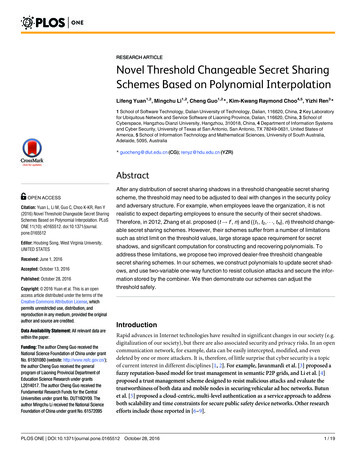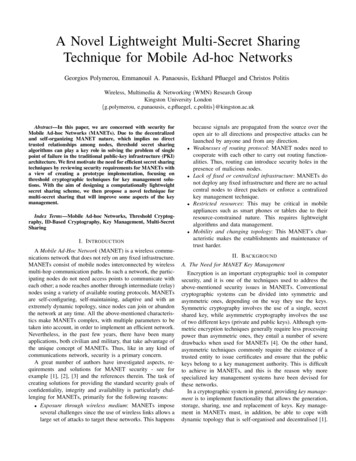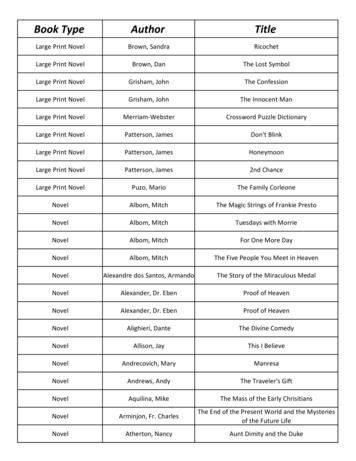
Transcription
RESEARCH ARTICLENovel Threshold Changeable Secret SharingSchemes Based on Polynomial InterpolationLifeng Yuan1,2, Mingchu Li1,2, Cheng Guo1,2*, Kim-Kwang Raymond Choo4,5, Yizhi Ren3*1 School of Software Technology, Dalian University of Technology, Dalian, 116620, China, 2 Key Laboratoryfor Ubiquitous Network and Service Software of Liaoning Province, Dalian, 116620, China, 3 School ofCyberspace, Hangzhou Dianzi University, Hangzhou, 310018, China, 4 Department of Information Systemsand Cyber Security, University of Texas at San Antonio, San Antonio, TX 78249-0631, United States ofAmerica, 5 School of Information Technology and Mathematical Sciences, University of South Australia,Adelaide, 5095, Australiaa11111* guocheng@dlut.edu.cn (CG); renyz@hdu.edu.cn (YZR)AbstractOPEN ACCESSCitation: Yuan L, Li M, Guo C, Choo K-KR, Ren Y(2016) Novel Threshold Changeable Secret SharingSchemes Based on Polynomial Interpolation. PLoSONE 11(10): e0165512. doi:10.1371/journal.pone.0165512Editor: Houbing Song, West Virginia University,UNITED STATESReceived: June 1, 2016Accepted: October 13, 2016Published: October 28, 2016Copyright: 2016 Yuan et al. This is an openaccess article distributed under the terms of theCreative Commons Attribution License, whichpermits unrestricted use, distribution, andreproduction in any medium, provided the originalauthor and source are credited.Data Availability Statement: All relevant data arewithin the paper.Funding: The author Cheng Guo received theNational Science Foundation of China under grantNo. 61501080 (website: http://www.nsfc.gov.cn/);the author Cheng Guo received the generalprogram of Liaoning Provincial Department ofEducation Science Research under grantsL2014017. The author Cheng Guo received theFundamental Research Funds for the CentralUniversities under grant No. DUT16QY09. Theauthor Mingchu Li received the National ScienceFoundation of China under grant No. 61572095After any distribution of secret sharing shadows in a threshold changeable secret sharingscheme, the threshold may need to be adjusted to deal with changes in the security policyand adversary structure. For example, when employees leave the organization, it is notrealistic to expect departing employees to ensure the security of their secret shadows.Therefore, in 2012, Zhang et al. proposed (t ! t0 , n) and ({t1, t2, , tN}, n) threshold changeable secret sharing schemes. However, their schemes suffer from a number of limitationssuch as strict limit on the threshold values, large storage space requirement for secretshadows, and significant computation for constructing and recovering polynomials. Toaddress these limitations, we propose two improved dealer-free threshold changeablesecret sharing schemes. In our schemes, we construct polynomials to update secret shadows, and use two-variable one-way function to resist collusion attacks and secure the information stored by the combiner. We then demonstrate our schemes can adjust thethreshold safely.IntroductionRapid advances in Internet technologies have resulted in significant changes in our society (e.g.digitalization of our society), but there are also associated security and privacy risks. In an opencommunication network, for example, data can be easily intercepted, modified, and evendeleted by one or more attackers. It is, therefore, of little surprise that cyber security is a topicof current interest in different disciplines [1, 2]. For example, Javanmardi et al. [3] proposed afuzzy reputation-based model for trust management in semantic P2P grids, and Li et al. [4]proposed a trust management scheme designed to resist malicious attacks and evaluate thetrustworthiness of both data and mobile nodes in securing vehicular ad hoc networks. Butunet al. [5] proposed a cloud-centric, multi-level authentication as a service approach to addressboth scalability and time constraints for secure public safety device networks. Other researchefforts include those reported in [6–9].PLOS ONE DOI:10.1371/journal.pone.0165512 October 28, 20161 / 19
Novel TCSS Scheme Based on Polynomial Interpolation(website: http://www.nsfc.gov.cn/); thesefoundation supported the preparation of thismanuscript.Competing Interests: The authors have declaredthat no competing interests exist.Cryptography is an important tool used to ensure data security (e.g. confidentiality). However, the security level is generally determined by the security level of the stored secret key. In1979, Shamir [10] and Blakley [11] independently proposed (t, n) threshold secret sharing(TSS) scheme designed to protect the secret by distributing a secret among a group of n participants. Only t or more participants in this group can cooperate to recover the secret. The (t, n)threshold secret sharing scheme has been used in various applications, such as in banks to protect the master key, and in certification authorities to protect the private root certificate keys.We refer interested reader to [12–14] for surveys of (t, n) threshold secret sharing schemes.In practice, the threshold may have to be adjusted if there are changes in the security policiesand adversary structures prior to recovering the secret. Examples of changes that requirethreshold to be adjusted include: (1) an increase or decrease in the importance level of thesecret; (2) a change in participants number (i.e., one or more participants joining or leaving thegroup); (3) a change in the level of mutual trust between participants; and (4) the leakage ofsome participants’ secret shadows. In 1989, Laih et al. [15] proposed the first threshold changeable secret sharing (TCSS) scheme to solve this problem. Since then, several other TCSSschemes based on different methods, such as polynomial interpolation [16–18], lattice basisreduction [19–21], and random noise [22], have been proposed in the literature.In a naive implementation of the TCSS scheme, a dealer constructs new secret shadows forparticipants in the new access structure once the threshold is changed. Thus, the dealer needsto hold the secret online and the attacker only needs to defeat the dealer to obtain the secret.To avoid such an attack, Desmedt and Jajodia [23] used the secret shadow redistributing technique in their proposed TCSS scheme, which does not require the dealer’s participation afterthe initialization phase. Similar schemes have also been presented in [24, 25]. In these schemes,each original secret shadow needs to be split into smaller shadows, which are redistributed toall participants in the new access structure. Each participant Pi combines all received smallersecret shadows into one new secret shadow si0 using a suitable linear combination; thus, eachparticipant only needs to store si0 . Note that all participants are required to simultaneouslymaintain mutual secure communication channels. However, this may be impractical when thethreshold changes, especially when the change is sudden.To avoid the requirement of maintaining mutual secure communication channels, severalTCSS schemes [16, 17, 26–28] based on broadcasting were proposed. In the schemes describedin [17, 26], the dealer validates the new threshold by broadcasting a suitable number of her/hisown redundant secret shadows. For example, in the scheme of [26], the dealer constructs a(n 1, 2n) threshold scheme with n redundant secret shadows, and then, sends n normalsecret shadows to n participants. If the threshold needs to be changed to t0 , the dealer broadcasts n t0 1 redundant secret shadows. Then, t0 or more participants can reconstruct thesecret by providing their own secret shadows. In other schemes, in order to validate the newthreshold, the dealer broadcasts special information, such as a mask code for the secret [27]and a key for encrypting/decryptingsecret shadows [16]. In these schemes discussed, thedealer prepares all secret shadows (also known as advance secret shadows) for potentialchangeable thresholds during the initialization phase.Other efforts have also been made on the security and application of TCSS techniques. In2013, for example, Rao et al. [29] proposed a dynamic threshold multi-secret sharing schemeusing Pell’s Equation with Jacobi symbol. In their scheme, participants can verify their secretshadows, which avoid the situation of participants receiving the nugatory information given bythe dealer. More recently, in 2015, Wang et al. [30] proposed a dynamic threshold changeablemulti-policy secret sharing scheme, based on RSA cryptography and discrete logarithm technique. Their scheme reduces the communication costs and can resist multiform cheating. Inthe same year, Harn and Hsu [31] proposed a threshold changeable secret sharing schemePLOS ONE DOI:10.1371/journal.pone.0165512 October 28, 20162 / 19
Novel TCSS Scheme Based on Polynomial Interpolationbased on bivariate polynomial, designed to protect the reconstructed secret from illegalparticipants.Zhang et al. [16] proposed (t ! t0 , n) and ({t1, t2, , tN}, n) TCSS schemes (hereafterreferred to as TCSS-A and TCSS-B schemes). The TCSS-B scheme was the first scheme thatcould resist collusion attacks launched by participants who have historical secret shadows.However, their schemes suffer from a number of limitations, namely: strict limit on thresholdvalues, large storage space requirement for secret shadows, and significant computationrequirement for constructing and recovering polynomials. Thus, in this paper, we propose twoimproved dealer-free threshold changeable secret sharing schemes, DTCSS-A and DTCSS-Bschemes. In our schemes, we construct polynomials to update secret shadows, and use two-variable one-way function to resist collusion attacks and protect the information stored by thecombiner. Compared with Zhang et al.’s schemes, our schemes have following advantages:1. No limitation on threshold values. New threshold t0 must be greater than initial threshold tin the TCSS-A scheme, and N potential thresholds t1, t2, , tN must satisfy 0 ti 1 ti t1(i 1, 2, , N 1) in the TCSS-B scheme. However, such limitations are avoided in ourschemes.2. Only one shadow storage requirement. Each participant needs to store t0 t 1 secret shadows in the TCSS-A scheme and N secret shadows in the TCSS-B scheme. In our schemes,only one secret shadow needs to be stored.3. Less computation. A total of t0 t 1 polynomials need to be constructed and recovered inthe TCSS-A scheme, and N polynomials need to be constructed and recovered in theTCSS-B scheme. In our schemes, only one polynomial needs to be constructed and recovered. Thus, our schemes require significantly less computational effort.4. Dealer-free. Zhang et al.’s schemes require the dealer’s assistance in the running phase,unlike our schemes. Thus, our schemes can reduce the single point-of-attack risk (i.e.,attackers only need to target the dealer in the attempt to obtain the secret).5. Secret shadow reusability. In our scheme, the secret shadow can be reused in new secretreconstruction; thus, increasing the efficiency.The rest of this paper is organized as follows. Section 2 introduces related concepts, two-variable one-way function and the obligations of participants. The proposed threshold changeableschemes are presented in Section 3. In Section 4, we demonstrate the security of our schemes,and evaluate the performance of our schemes with those of Zhang et al.’s. We also discuss howour schemes can deal with the situation where the threshold needs to be adjusted. Section 5concludes the paper.PreliminariesIn this section, we explain the relevant concepts, two-variable one-way function and the obligations of participants.ConceptionsWe introduce the related conceptions as follows:(1) Communication modesTwo communication modes are used in TCSS schemes (i.e. secure communication channelsand broadcasting). It may be impractical to maintain mutual secure communication whenthe threshold changes, especially when the change is sudden. In our schemes, importantPLOS ONE DOI:10.1371/journal.pone.0165512 October 28, 20163 / 19
Novel TCSS Scheme Based on Polynomial Interpolationinformation such as real secret shadows are sent using RSA-based technique, and we validatethe new threshold using broadcasting. We refer interested readers to [32–34] for an overviewof secure communication techniques, as this is beyond the scope of this paper.(2) Dealer-freeTSS technology is generally used to protect the secret key. For example, even if n t participants lose their secret shadows, the remaining t participants are still able to recover the secret.Deploying TSS scheme can also improve the security of the system, as an attacker requires noless than t secret shadows to recover the secret. In traditional TSS schemes, after generatingand distributing secret shadows, the dealer destroys the secret and exits. While in some TCSSschemes, the dealer is online until the secret is recovered by participants. For example, inZhang et al.’s schemes, since the dealer needs to adjust the threshold and deal with the enrollment and disenrollment of the participant, he/she holds the secret and all secret shadows in therunning phase until the secret is recovered. Thus, attackers only need to target the dealer in theattempt to obtain the secret. This results in single point of attack.However, in our schemes, we use the combiner to take the dealer’s obligations in the running phase, and use two-variable one-way function to protect the information stored by thecombiner. Thus, our schemes can update / revise the threshold in the running phase withoutthe dealer’s involvement, which means our schemes is dealer-free. Meanwhile, our schemesprotect the secret from being recovered when attackers have access to the information storedby the combiner. Hence, our schemes are more secure.(3) Collusion attackThe (t, n) threshold secret sharing scheme can resist up to t 1 collusion participants whohave secret shadows. However, in the TCSS schemes of [21, 24, 28] based on the advance secretshadow technique, participants have both historical and current secret shadows after changingthe threshold. Therefore, such schemes cannot resist attacks carried out by t 1 colluding participants. Many schemes [21, 24, 28] require that all participants destroy the historical shadowsif the threshold has been changed, but this may be unrealistic in practice (i.e. we are trustingthe bad guys to do the right thing). Thus, Zhang et al. [16] proposed the first scheme (i.e.TCSS-B) designed to resist such collusion attack, by encrypting secret shadows and validatingthe new threshold with the corresponding key. In our schemes, two-variable one-way functionis used to protect secret shadows from collusion attacks.Two-variable One-way FunctionIn this section, we introduce two-variable one-way function used in our schemes. Function f(r, s)is a two-variable one-way function, which maps variables r and s into a value with a fixed length.The features of f(r, s) are as follows [35]:1. Given r and s, it is easy to compute f(r, s).2. Given s and f(r, s), it is not feasible to compute r.3. It is not feasible to compute f(r, s) for any r without s.4. Given s, it is not feasible for ri and rj to satisfy f(ri, s) f(rj, s), when ri 6¼ rj.5. Given any pairs of (ri, f(ri, s)), it is not feasible to compute s.6. Given any pairs of (ri, f(ri, s)), it is not feasible to compute f(rj, s), when ri 6¼ rj.Assume that f(r, s) q, so f(r, s) 2 GF(q). He and Dawson [36] proved the existence of twovariable one-way function, and also brought up the methods to construct it. For example, let S bea secure signature scheme. For a message m, the signature with secure key k is denoted by S(k, m).PLOS ONE DOI:10.1371/journal.pone.0165512 October 28, 20164 / 19
Novel TCSS Scheme Based on Polynomial InterpolationLet H be a universal one-way hash function whose existence is based on any one-to-one, one wayfunction [37]. Two-variable one-way function f(x, y) can be constructed as f(x, y) H(S(x, y)).In our schemes, each participant Pi (1 i n) selects his/her own variable si (also referredto as real secret shadow), and the combiner has all variables r1, r2, , rk (k tmax tmin 1 inDTCSS-A scheme and k N in DTCSS-B scheme). By using two-variable one-way function,our schemes have the following advantages:1. Collusion attack resistance: In our schemes, if and only if no less than current threshold(i.e., tj) participants wish to recover the secret, the combiner broadcasts the correspondingvariant rj to validate participants’ fake secret shadows. Colluding participants cannot obtainthe historical shadows to recover the secret. Thus, our schemes can resist attacks carried outby tj 1 colluding participants who have both current and historical shadows.2. Single point attack resistance: In our schemes, even if attackers obtain the information rjstored in the combiner, they cannot compute the f(rj, si) without si. Thus, our schemes canavoid the limitation that attackers only need to target a single point in the attempt to obtainthe secret.3. Real secret shadow reusability: In our scheme, the real secret shadow can be reused in newsecret reconstruction, thus, increasing the efficiency.ParticipantsThere are n 2 (n 2) members in our schemes, including n participants, the dealer and thecombiner. The obligations of these participants are as follows:Participants: There are n participants who hold secret shadows. In the running phase, onlyequal to or greater than threshold value participants can cooperate to recover the secret.The dealer: In the initialization phase, the dealer generates each participant’s advance secretshadows, and prepares for possible threshold change.The combiner: In the running phase, the combiner adjusts the threshold value according tochanges in the security policies and adversary structures prior to recovering the secret. Only ifequal to or greater than threshold participants wish to recover the secret, then the combinerbroadcasts the corresponding key to validate these participants’ current secret shadows. Oncesuccessfully validated, these participants can recover the secret.In generally, there are only participants and dealers in (t, n) threshold secret sharing scheme.However, to avoid the dealer single point attack, we introduce a combiner. The combiner canbe used to adjust threshold and validate participants’ corresponding secret shadows. Weassume both dealer and combiner are trusted.Proposed SchemesIn this section, we introduce our schemes (i.e., DTCSS-A and DTCSS-B schemes). The notionsand parameters used in our schemes are outlined in Table 1.In our two DTCSS schemes, there are n 2 (n 2) members (i.e., n participants, the dealerand the combiner), and their message flows are shown in Fig 1. Specifically, real secret shadows(sent to the dealer by participants) and shadow activation information (sent to the combiner bythe dealer) are sent using RSA-based technique, and other information is sent via broadcasting.(t ! t 0 , n) Threshold Changeable SchemeIn this section, we present the dealer-free threshold changeable secret sharing scheme basedon broadcasting (DTCSS-A), where the polynomial is used as the secret shadow updatingPLOS ONE DOI:10.1371/journal.pone.0165512 October 28, 20165 / 19
Novel TCSS Scheme Based on Polynomial InterpolationTable 1. Summary of Notations.NotationMeaningnNumber of participantstThreshold valuePiParticipant iPParticipant set, P {P1, P2, , Pn}qA big prime number randomly chosen by the dealer, q nSDomain of the secret, S GF(q)sSecret, s 2 SSiDomain of participant Pi’s secret shadow, Si GF(q)siParticipant Pi’s secret shadow, si 2 SiTDomain of potential thresholdt0New threshold in DTCSS-A schemeNNumber of potential thresholds in DTCSS-B schemeh(x)A polynomialh(xi)Value of polynomial h(x) in a given xiyijParticipant Pi’s jth advance secret shadowψiParticipant Pi’s secret shadow updating functionf(r, s)A two-variable one-way functiondeg( )Operator is used for computing the degree of the polynomial[xk]Coefficient operator. If h(x) i 0aixi, then [xk] h(x) ak.Pk 1Polynomial operator. If h(x) i 0aixi, ½hðxÞ k ¼ i¼0 ai xi .[ ]kdoi:10.1371/journal.pone.0165512.t001function. This scheme is designed to convert a (t, n) scheme into a (t0 , n) scheme, where tmin t0 tmax.Assume that the dealer knows the changeable threshold domain T {tmin, tmin 1, , tmax},where 2 tmin tmax n and tmax ; t min 2 Z. Then, using the RSA-based technique, theFig 1. Sequence diagram of our schemes.doi:10.1371/journal.pone.0165512.g001PLOS ONE DOI:10.1371/journal.pone.0165512 October 28, 20166 / 19
Novel TCSS Scheme Based on Polynomial Interpolationdealer negotiates the real shadow with each participant. The dealer generates each participant’sadvance secret shadows and secret shadow updating function, and publishes these functions.Prior to exiting, the dealer sends the information used to validate the secret shadow to the combiner. Based on any updates to the security policy and adversary structure, the combineradjusts the threshold to a suitable value t0 . If no less than t0 participants wish to recover thesecret, then the combiner broadcasts rtt0 t þ1 . Therefore, these participants can recover theminsecret. DTCSS-A scheme consists of three phases as follows:1. Secret shadows negotiation phaseIn this phase, the dealer creates the notice table. Participants choose their own real secretshadows, and send them to the dealer using the underlying RSA technique. This phase has thefollowing steps:1. Notice table creation: To broadcast the message, the dealer creates a notice table, which canonly be used for broadcasting information by the dealer and the combiner. Participants canobtain the information from the notice table, but they are unable to broadcast or modify thetable.2. Secret shadows negotiation initialization: Let M1 p1 p2 and φ(M1) (p1 1) (p2 1),where p1, p2 are big prime numbers chosen randomly by the dealer. The dealer chooses aninteger e1 φ(M1), which is co-prime with φ(M1). Then, the dealer computes the integerd1, such that e1 d1 1ðmodφðM1 ÞÞ, and broadcasts {e1, M1} in the notice table. Similar, thecombiner also generates his/her own {e2, d2, M2}, and broadcasts {e2, M2} in the notice table.3. Real secret shadow generation and transfer: Each participant Pi (1 i n) chooses a realsecret shadow si 2 Si randomly and sends Ci to the dealer, where Ci ¼ ðsi Þe1 mod M1 . Afterreceiving Ci, the dealer recovers the real secret shadow si ¼ ðCi Þd1 mod M1 , and thenensures all participants choose distinct secret shadows. If two or more participants choosethe same secret shadow, they will be asked to choose their secret shadows again until allsecret shadows are distinct.2. Initialization phaseIn this phase, the dealer constructs the polynomial and generates each participant’s advanceshadows. The work-flow of this phase is shown in Fig 2, and the working steps are as follows:(1) Polynomial construction: To share a secret s 2 S, the dealer constructs polynomial h(x) ashðxÞ ¼ ðs þ a1 x1 þ þ atmax 1 xtmax 1 Þ mod q;ð1Þwhere a1, a2, , atmax 1 2 GF(q) are chosen randomly. Let hj(x) [h(x)]tmin j 1 for all 1 j tmax tmin 1. Polynomial hj(x) can be generated by Algorithm 1.Algorithm 1: Polynomial generator 1Input: h(x), j, tmin, tmaxOutput: hj(x)hj(x) h(x);d tmin j 1;While d tmax 1 doc [xd]h(x);hj(x) hj(x) cxd;d d 1;end(2) Secret shadow updating functions construction: The dealer selects tmax tmin 1 distinctand nonzero integers r1, r2, , rtmax tmin 1 2 GF(q) as keys. There is one-to-one correspondencePLOS ONE DOI:10.1371/journal.pone.0165512 October 28, 20167 / 19
Novel TCSS Scheme Based on Polynomial InterpolationFig 2. The work-flow of the initialization phase of DTCSS-A n keys r1, r2, , rtmax tmin 1 and thresholds tmin, tmin 1, , tmax. Then, each participant’sadvance secret shadows yi1 ; yi2 ; ; yitmax tminþ1 (1 i n) can be computed asyij ¼ hj ðxij Þ ðj ¼ 1; 2; ; tmaxtmin þ 1Þ;ð2Þwhere xij ¼ f ðrj ; si Þ.With tmax tmin 1 points ðxi1 ; yi1 Þ; ðxi2 ; yi2 Þ; ; ðxitmax tmin þ1 ; yitmax tmin þ1 Þ, each participant’ssecret shadow updating function ψi (1 i n) can be constructed as follows:ci ðxÞ ¼Ptmaxj¼1tmin þ1yijQtmaxtmin þ1k¼1;k6¼jxxijxikmod q:xikð3ÞThen, these functions are placed into notice table.(3) Data transfer: To validate the new threshold in next phase, the dealer sends keys r1, r2, ,rtmax tmin 1 to the combiner before exiting. Note that these keys need to be encrypted by the combiner’s public key. Upon receiving this encrypted information, the combiner decrypts it.3. Running phaseIn this phase, the security policy and adversary structure may change, which necessitates athreshold change prior to recovering the secret. Once the threshold has been revised, the secretcan then be recovered with the most recently broadcasted threshold. The work-flow of the running phase is shown in Fig 3, and the working steps are as follows:PLOS ONE DOI:10.1371/journal.pone.0165512 October 28, 20168 / 19
Novel TCSS Scheme Based on Polynomial InterpolationFig 3. The work-flow of the running phase of DTCSS-A scheme.doi:10.1371/journal.pone.0165512.g003(1) Threshold adjustment: Based on the changes in the security policy and adversary structure, the combiner selects a suitable threshold t0 (tmin t0 tmax), and inserts it into the noticetable. The threshold can be adjusted many times before the secret is recovered.(2) Shadow activation: If participants wish to recover the secret, they can send the recoveryrequests to the combiner. When t0 or more participants wish to recover secret s, the combinerbroadcasts corresponding key rtt0 t þ1 . Then, each participant Pi (1 i n) can obtain her/hismin000current secret shadow yit tmin þ1 ¼ ci ðxit tmin þ1 Þ, where xit tmin þ1 ¼ f ðrt0 tmin þ1 ; si Þ.(3) Secret recovery: Without loss of generality, we assume that t0 participants P1, P2, , Pt0wish to recover secret s. With t0 points000ðx1t tmin þ1 ; y1t tmin þ1 Þ; ðx2tbe recovered asht0where xit0tmin þ1tmin þ1tmin þ1 ðxÞ ¼¼ f ðrt0PLOS ONE DOI:10.1371/journal.pone.0165512 October 28, 2016tmin þ10; y2tPt0tmin þ1ti¼1 yi00Þ; ; ðxtt0tmin þ1tmin þ1Qt 0j¼1;j6¼ixxit00; ytt0tmin þ1xjttmin þ10Þ, polynomial ht tmin 1(x) can0tmin þ1xjt0tmin þ1mod q;ð4Þ; si Þ (1 i t0 ).9 / 19
Novel TCSS Scheme Based on Polynomial InterpolationThen, we can recover secret s by computing s ht0 tmin 1(0).({t1, t2, , tN}, n) Threshold Changeable SchemeIn this section, we present our ({t1, t2, , tN}, n) TCSS scheme (i.e., DTCSS-B scheme). Usually, Nis a small integer. For example, when N 3, {t1, t2, t3} correspond to the “low, middle, high” levelof security in computers. Meanwhile, even if tN is small, we always have tj j for all 1 j N.Let tk (1 k N) be the value of initial threshold, and tj (1 j N) be the value of thenew threshold. Assume that the dealer knows N potential thresholds t1, t2, , tN, where thethreshold may be changed in the future and t1 t2 tN. Similar to the DTCSS-Ascheme, the dealer negotiates the real shadow. The dealer generates each participant’s advancesecret shadow. Prior to exiting, the dealer sends the information used to update and validatesthe secret shadow to the combiner. If the security policy or adversary structure changes, thenthe combiner adjusts the threshold to a suitable value tj, and broadcasts correspondingmasked advance secret shadows. If no less than tj participants wish to recover the secret, thenthe combiner broadcasts rj. Thus, these participants can recover the secret. The DTCSS-Bscheme consists of three phases, namely: secret shadows negotiation, initialization andrunning.1. Secret shadows negotiation phaseSimilar to the DTCSS-A scheme, the dealer creates the notice table, and participantschoose their own real secret shadows and send them to the dealer based on the underlyingRSA technique.2. Initialization phaseIn this phase, the dealer constructs the polynomial to protect the secret and generates theadvance secret shadows for all participants. The work-flow of the running phase is shown inFig 4, and the working steps are as follows:(1) Polynomial construction: To share a secret s, polynomial h(x) is constructed ashðxÞ ¼ ðs þ a1 x1 þ þ atN 1 xtN 1 Þ mod q;ð5Þwhere a1, a2, , atN 1 2 GF(q) are chosen randomly. For all 1 j N, let polynomial hj(x) [h(x)]tj. Polynomial hj(x) can be generated by Algorithm 2.Algorithm 2: Polynomial generator 2Input: h(x), j, tj, tNOutput: hj(x)hj(x) h(x);d tN tj;While d 0 doc [xtj d 1]h(x);hj(x) hj(x) cxtj d 1;d d 1;end(2) Advance secret shadows generation: The dealer chooses N distinct and nonzero integersr1, r2, , rN 2 GF(q) as keys. There is one-to-one correspondence between keys r1, r2, , rNand potential thresholds t1, t2, , tN. Each participant’s advance secret shadows yi1 ; yi2 ; ; yiN(1 i n) are computed as follows:yij ¼ hj ðf ðrj ; si ÞÞ ðj ¼ 1; 2; ; NÞð6ÞThen, the dealer places masked advance secret shadowsy f ðrk ; s1 Þ; y2k f ðrk ; s2 Þ; ; ynk f ðrk ; sn Þ into the notice table.k1PLOS ONE DOI:10.1371/journal.pone.0165512 October 28, 201610 / 19
Novel TCSS Scheme Based on Polynomial InterpolationFig 4. The work-flow of the initialization phase of DTCSS-B scheme.doi:10.1371/journal.pone.0165512.g004(3) Data transfer: To validate the new threshold by the combiner in the next phase, thedealer sends y1j f ðrj ; s1 Þ; y2j f ðrj ; s2 Þ; ; ynj f ðrj ; sn Þ (j 1, 2, , N) and r1, r2, , rN to the combiner, and then, he/she exits. Note that this information needs to be encrypted by the combiner’s the public key. After receiving this encrypted information, the combiner decrypts it
secret; (2) a change in participants number (i.e., one or more participants joining or leaving the group); (3) a change in the level of mutual trust between participants; and (4) the leakage of some participants' secret shadows. In 1989, Laih et al. [15] proposed the first threshold change-able secret sharing (TCSS) scheme to solve this problem.










